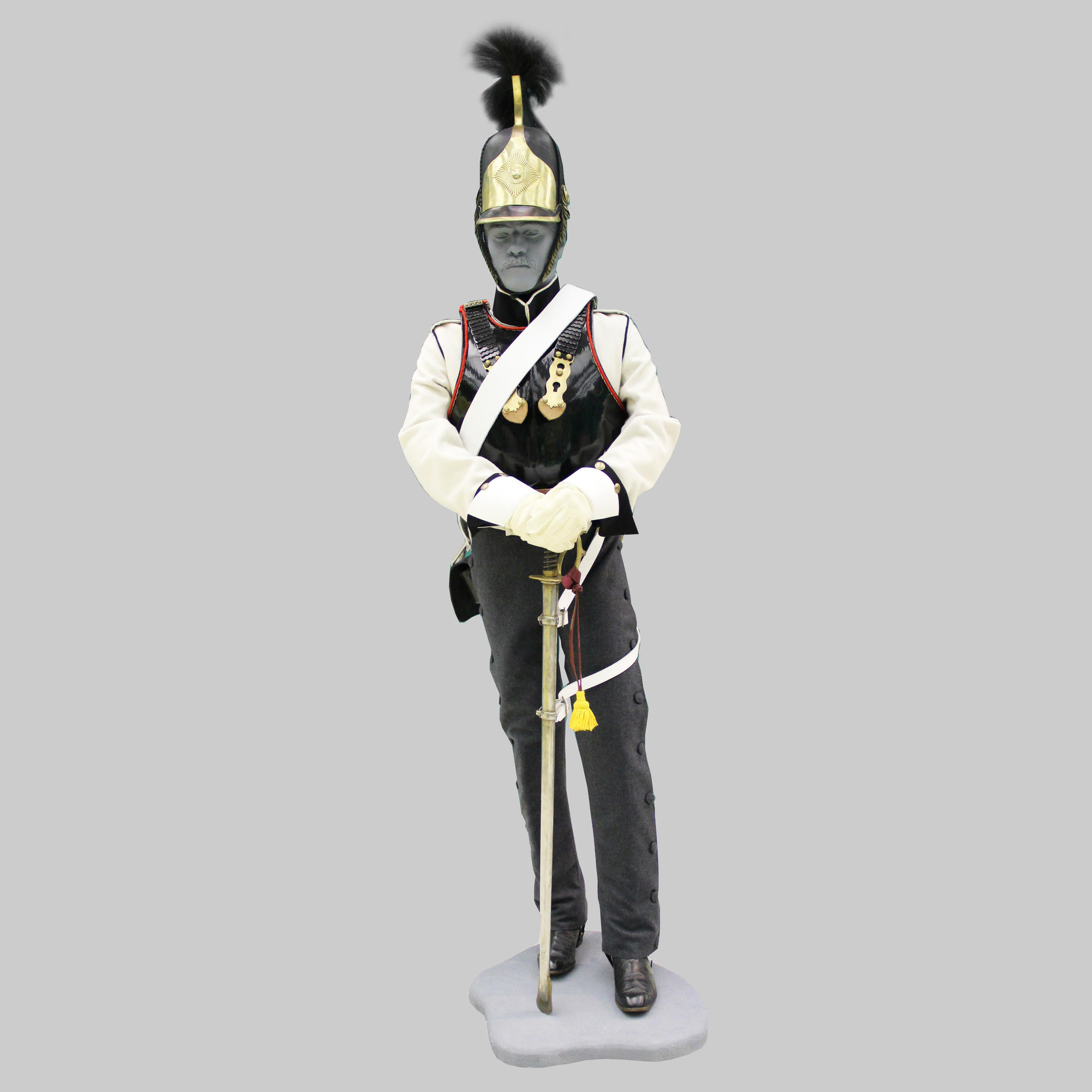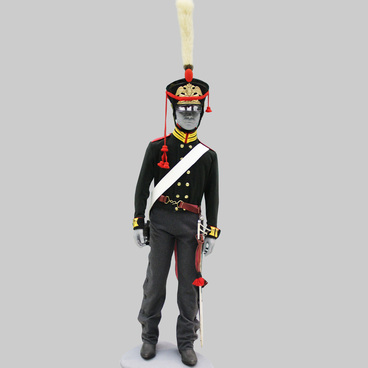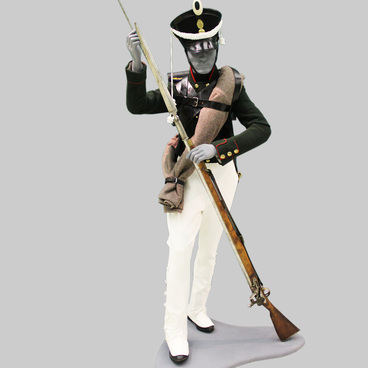In 1812, regular cavalry was divided into heavy (dragoon and cuirassier regiments) and light (hussar and uhlan regiments). The heavy cavalry was intended for actions in close formation against the enemy cavalry and infantry. Literally, the word cuirassier means an armour-clad warrior from the French word ‘cuirasse’, which means plate armour. A cuirasse is a coat of mail protecting the horseman’s body. In 1812, regular cavalry was divided into heavy (dragoon and cuirassier regiments) and light (hussar and uhlan regiments). The heavy cavalry was intended for actions in close formation against the enemy cavalry and infantry. Literally, the word cuirassier means an armour-clad warrior from the French word “cuirasse”, which means plate armour. A cuirasse is a coat of mail protecting the horseman’s body.
On August 26, 1812 in the Battle of Borodino His Majesty’s Life Guard Cuirassier Regiment was repulsing the attacks of the enemy heavy cavalry in the vicinity of the Semyonvskoye village. The regiment’s actions were depicted by artist Franz Roubaud on his panorama, the central exhibit of the Museum-Panorama “Battle of Borodino.”
The cuirassier wears the helmet of the 1808 model. This head-gear was made from thick leather and was fitted with additional reinforcing bars. On top of the helmet there is a leather comb with a hackle, an upright horsehair ornamental crest.
The copper forehead plate of the helmet carried the regiment’s emblem. The helmets of the cuirassier regiment decorated with a military order featured forehead plates with the star of the Order of Saint George. In guard regiments, the emblem was the star of the Order of St.Andrew the First Called, while in army regiments it was the two-headed eagle.
The cuirasse of the private is a model of 1812. This protective element of the gear consisted of two iron plates, one on the chest, one on the back, fixed on the shoulders and on the waist with leather straps. The shoulder straps were covered with metal scales. In the Russian Army the cuirasses were covered with black oil paint and varnish.
A jerkin, a short uniform jacket of a cuirassier, was tailoured in the Russian Army from white thick cloth or kersey, coarse woolen fabric. On top of the main clothes soldiers wore field pantaloons made from grey cloth for protection against dirt and wear.
The private is armed with a cuirassier broadsword of the 1809 model in a steel scabbard. A broadsword is a cold stabbing weapon with a straight single-edged blade which is double-edged at the end, i.e.sharpened from both sides. The total length of the broadsword is 110 cm.
Russian cuirassiers wore a waist belt or a sword sling fitted with two belts to suspend the broadsword. Hung on the waist belt behind the cuirassier’s back, there is a cartridge pouch, a cavalryman’s ammunition box. The cartridge pouch was used to carry 30 cartridges, as well as an iron ramrod for pistols attached to it.
On August 26, 1812 in the Battle of Borodino His Majesty’s Life Guard Cuirassier Regiment was repulsing the attacks of the enemy heavy cavalry in the vicinity of the Semyonvskoye village. The regiment’s actions were depicted by artist Franz Roubaud on his panorama, the central exhibit of the Museum-Panorama ‘Battle of Borodino.’
The cuirassier wears the helmet of the 1808 model. This head-gear was made from thick leather and was fitted with additional reinforcing bars. On top of the helmet there is a leather comb with a hackle, an upright horsehair ornamental crest.
The copper forehead plate of the helmet carried the regiment’s emblem. The helmets of the cuirassier regiment decorated with a military order featured forehead plates with the star of the Order of Saint George. In guard regiments, the emblem was the star of the Order of St.Andrew the First Called, while in army regiments it was the two-headed eagle.
The cuirasse of the private is a model of 1812. This protective element of the gear consisted of two iron plates, one on the chest, one on the back, fixed on the shoulders and on the waist with leather straps. The shoulder straps were covered with metal scales. In the Russian Army the cuirasses were covered with black oil paint and varnish.
A jerkin, a short uniform jacket of a cuirassier, was tailoured in the Russian Army from white thick cloth or kersey, coarse woolen fabric. On top of the main clothes soldiers wore field pantaloons made from grey cloth for protection against dirt and wear.
The private is armed with a cuirassier broadsword of the 1809 model in a steel scabbard. A broadsword is a cold stabbing weapon with a straight single-edged blade which is double-edged at the end, i.e.sharpened from both sides. The total length of the broadsword is 110 cm.
Russian cuirassiers wore a waist belt or a sword sling fitted with two belts to suspend the broadsword. Hung on the waist belt behind the cuirassier’s back, there is a cartridge pouch, a cavalryman’s ammunition box. The cartridge pouch was used to carry 30 cartridges, as well as an iron ramrod for pistols attached to it.
On August 26, 1812 in the Battle of Borodino His Majesty’s Life Guard Cuirassier Regiment was repulsing the attacks of the enemy heavy cavalry in the vicinity of the Semyonvskoye village. The regiment’s actions were depicted by artist Franz Roubaud on his panorama, the central exhibit of the Museum-Panorama “Battle of Borodino.”
The cuirassier wears the helmet of the 1808 model. This head-gear was made from thick leather and was fitted with additional reinforcing bars. On top of the helmet there is a leather comb with a hackle, an upright horsehair ornamental crest.
The copper forehead plate of the helmet carried the regiment’s emblem. The helmets of the cuirassier regiment decorated with a military order featured forehead plates with the star of the Order of Saint George. In guard regiments, the emblem was the star of the Order of St.Andrew the First Called, while in army regiments it was the two-headed eagle.
The cuirasse of the private is a model of 1812. This protective element of the gear consisted of two iron plates, one on the chest, one on the back, fixed on the shoulders and on the waist with leather straps. The shoulder straps were covered with metal scales. In the Russian Army the cuirasses were covered with black oil paint and varnish.
A jerkin, a short uniform jacket of a cuirassier, was tailoured in the Russian Army from white thick cloth or kersey, coarse woolen fabric. On top of the main clothes soldiers wore field pantaloons made from grey cloth for protection against dirt and wear.
The private is armed with a cuirassier broadsword of the 1809 model in a steel scabbard. A broadsword is a cold stabbing weapon with a straight single-edged blade which is double-edged at the end, i.e.sharpened from both sides. The total length of the broadsword is 110 cm.
Russian cuirassiers wore a waist belt or a sword sling fitted with two belts to suspend the broadsword. Hung on the waist belt behind the cuirassier’s back, there is a cartridge pouch, a cavalryman’s ammunition box. The cartridge pouch was used to carry 30 cartridges, as well as an iron ramrod for pistols attached to it.



